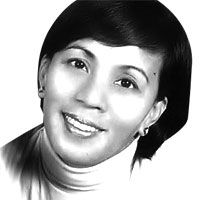On deaths of botanist, 2 others: Human rights body ends probe

TACLOBAN CITY , Philippines —The Commission on Human Rights, headed by its chairperson Loretta "Etta" Rosales, the other day concluded its two-day public inquiry on the killing of renowned botanist Dr. Leonardo Co and his two men in Kananga, Leyte last Nov. 15.
The CHR investigation, held at a hotel-resort in this city from Jan. 26 to 27, came after a three-man probe team of the Justice Department released its findings confirming that Co, Sofronio Cortez and Julius Borromeo were killed in a crossfire during a clash between the military and the communist rebels in a forested area of Brgy. Lim-ao in Kananga town.
The three, and two others who survived, formed a team that was commissioned by the Energy Development Corporation to conduct a study of trees at a forested area around the geothermal site for EDC's "trees of the future" project.
Among those who attended were the 85-year-old Lian Seng, father of Co, his family and his lawyer Evelyn Ursua, and some members of the Scene of the Crime Operations who gathered evidences from the crime scene, twice on separate days after the incident.
Co's father and Ursua told The FREEMAN of their dismay over the report of the DOJ panel clearing the military troops from criminal liability, and blaming even the EDC for lack of coordination with the soldiers resulting in exposure of the three civilians to situation, such as the encounter, leading to their deaths.
The victim's family said they were disappointed with the DOJ findings, and hoped the CHR to come up with justifiable findings. "As a father, it's my wish that the truth will come out, so justice must be served. That's the only thing we want," Co's father said.
"Ang hinihiling lang namin ay maibigay ang hustisya sa aming anak. Hindi kami papayag sa naging resulta ng imbestigasyon ng NBI at DOJ dito sa kasong ito," he told the media, adding that his son does not deserve to die in brutal manner.
The CHR has yet to release its findings from its recent inquiry, and Rosales only commented by saying: "The issue we are tackling right now is very important. Mahahalata natin ang systemic problem sa labanan between the military and the rebel group as there was a claim of crossfire between the two (resulting in the deaths of the three civilians)."
Rosales said the CHR, in its investigation, must tackle the judicial system, approaches and rules of engagements. "Solid and strong enough evidences must be established and gathered for these to hold water in court. Then we would recommend for the filing of appropriate charges to those responsible on the murder," she said.
During the morning session of the public inquiry, SOCO members were asked how they handled the gathering of evidences from the crime scene. Senior Insp. Randie Dagatan, team leader, said they were only informed about the killing the day after.
Dagatan said that, on Nov. 16, they were able to collect 24 empty slugs and another 60 during their second visit six days later. On why they were able to collect more empty slugs in the second visit, he said they went farther from the scene into an elevated area outside the cordon set up earlier by the Kananga Police.
Dagatan also said that, in their first visit, they were with Kananga policemen and the soldiers of the 19th Infantry Battalion who allegedly engaged the rebels in a gunbattle at the time of the encounter.
The CHR later found out there were two different cartographs of the crime scene submitted by SOCO to the inquiry, prompting it to ask SOCO's cartographer, PO1 Salvador Labareño, to submit the correct cartography.
In the first map, the arrow north direction appeared to be diagonal pointing downward while the second map shows the arrow of the north direction to be on upward direction. The correct direction should be "accurately" established to determine the trajectory of the bullets, Rosales said.
The CHR also questioned why SOCO did not consider the raincoat and the foods packed in styro-foams among the physical evidences and gathered only the empty slugs from the M16 rifles.
PO2 Ann Mitzi Valdenor, evidence collector, said they did take the two items but kept these at their office for "future reference."
The family of Co strongly protested the DOJ findings, and went on to file a complaint against 38 soldiers of the 19th IB. It also asked the DOJ to conduct a preliminary investigation to determine whether the respondents should be charged with murder for the deaths of Co and his two companions.
Ursua said a review of the DOJ panel's report would show that "the findings and the conclusions are flawed and contrary to evidence." She alleged that the soldiers' affidavits would show they did not have personal knowledge of the supposed presence of communist rebels.
"We really need the cooperation of the leadership of the AFP, kasi until now di pa na-submit lahat for ballistic examination the firearms used during the encounter, and other documents and information needed in the investigation for our evidence," Ursua said.
Ursua further cited the affidavits of the two survivors, alleging that no firefight occurred, and that the SOCO report allegedly disclosed that the victims' wounds showed they were shot from close range.
Senior Supt. Edgar Basbas, deputy director for operations of the Police Regional Office-8, for his part said: "We have already submitted the findings of our investigation to our head office in Camp Crame, hence the ball is already in the hands of the prosecution."
AFP Central Command chief, Lt. Gen. Ralph Villanueva, in a recent press statement said the military is willing to cooperate with the investigation, but he hoped that the soldiers, "like all accused, be accorded by the public with the presumption of innocence."
- Latest
- Trending


















